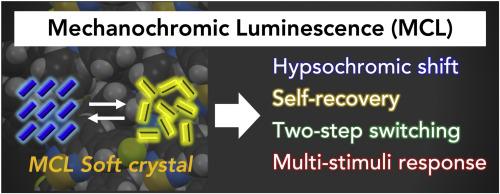Journal of Photochemistry and Photobiology C: Photochemistry Reviews ( IF 13.6 ) Pub Date : 2021-12-30 , DOI: 10.1016/j.jphotochemrev.2021.100481 Suguru Ito 1

|
Soft crystals are a class of smart materials that can switch their photophysical or mechanical properties in response to gentle external stimuli. A representative stimuli-responsive behavior of soft crystals is mechanochromic luminescence (MCL), i.e., a reversible color change of solid-state photoluminescence induced by external mechanical stimuli. Together with the rapid growth in the area of solid-state photoluminescence including fluorescence, room-temperature phosphorescence (RTP), thermally activated delayed fluorescence (TADF), white-light emission (WLE), and circularly polarized luminescence (CPL), a number of soft crystals that exhibit MCL behaviors have been reported during the past decade. In the typical MCL of soft crystals, the emission color switches in the bathochromic direction upon amorphization by grinding and recovers to the original color upon recrystallization by heating or exposure to organic solvents. Relatively few are known to exhibit hypsochromically shifted MCL, two-step MCL, self-recovering MCL, or mechanical-stimuli-induced single-crystal-to-single-crystal (SCSC) transitions. Rational design guidelines to control the mechanoresponsive properties of soft crystals have not yet been established. This review summarizes the systematic studies on the substituent effect to control the MCL properties of soft crystals. Recent studies provide useful insights into the effects of electronic and steric differences of substituents on crystal structure, luminescence properties, and mechanoresponsive behaviors.
中文翻译:

软晶体的机械致变色发光:控制分子堆积和机械响应特性的最新系统研究
软晶体是一类智能材料,可以响应温和的外部刺激而改变其光物理或机械特性。软晶体的代表性刺激响应行为是机械致变色发光 (MCL),即由外部机械刺激引起的固态光致发光的可逆颜色变化。随着固态光致发光领域的快速发展,包括荧光、室温磷光 (RTP)、热激活延迟荧光 (TADF)、白光发射 (WLE) 和圆偏振发光 (CPL),许多在过去的十年中,已经报道了表现出 MCL 行为的软晶体的数量。在软晶体的典型 MCL 中,研磨非晶化后发光颜色向红移方向转换,加热或暴露于有机溶剂重结晶后恢复到原始颜色。已知相对较少的 MCL、两步 MCL、自恢复 MCL 或机械刺激诱导的单晶到单晶 (SCSC) 转变。尚未建立控制软晶体机械响应特性的合理设计指南。本综述总结了控制软晶体 MCL 特性的取代基效应的系统研究。最近的研究为取代基的电子和空间差异对晶体结构、发光特性和机械响应行为的影响提供了有用的见解。



























 京公网安备 11010802027423号
京公网安备 11010802027423号